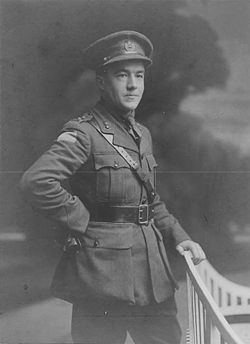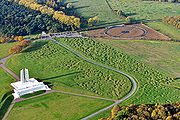Miller, Leslie Howard
Early Life
Leslie Miller was born October 5, 1889 on the family farm in Milliken, Ontario to William and Emma (nee Rinbrough) Miller. He had an older brother Henry and three younger sisters Irene, Isabelle and Elizabeth[2]. He was educated at the University of Toronto and employed as a teacher prior to enlisting[1].
Great War Service
Leslie declared he had no prior military service when he joined the Canadian Expeditionary Force at Winnipeg in December 1914.[3] He was enrolled in the 32nd Battalion and proceeded overseas. Once in England, the 32nd Battalion was designated a Reserve Battalion and Leslie was transferred to the 5th Battalion. In January 1917 he joined the Canadian Corps Wireless Section. Besides a few months in 1917 when he was attached to No. 1 Army Wireless Company , he remained with the Canadian Corps Wireless Section until June 1918, having reached the rank of Acting Sergeant, when he proceeded to England as a candidate for commissioning. In October 1918 he was commissioned a Lieutenant in the Canadian Engineers and transferred to 3rd Canadian Divisional Signal Company where he served until the end of the war. He proceeded to Canada in March 1919 and was discharged.
Personal Life
Following his discharge her returned to the family farm in Scarborough. He obtained a license in 1926 to wed Mary Isabel Fraser of Qu'appelle Saskatchewan. He died at the Veteran's Wing of Sunnybrook Hospital in 1979.[4]
Vimy Oaks
Leslie Miller sent acorns home to Canada that he had gathered up from Vimy Ridge. Planted on his family's farm, those acorns are now large majestic oaks that are growing on what is today the home of the Scarborough Chinese Baptist Church. Having unsuccessfully attempted to gather acorns from these trees (the squirrels won!) with a hope of returning oak trees to Vimy Ridge in France, it was decided to attempt to grow saplings through grafting. In January 2015, the process began with professional arborists taking cuttings (scions) from the crowns of the oaks which were grafted onto base root stock – quercus robur.[5] Citing concerns of importing diseases to Europe, those saplings, more than 1,000, were not allowed into France. The saplings were subsequently made available to communities across Canada in order to memorialize the 100th Anniversary of the battle. Later efforts to gather acorns from the original Vimy Oaks were successful and those were shipped to France where they were grown in a nursery prior to being planted at Vimy Ridge.[6]
On 9 November 2018 the Vimy Foundation Memorial Park was opened on 4 acres of land purchased by the foundation adjacent to the Vimy Memorial land. The park includes over 100 of the repatriated oak trees surrounding four concentric circles, each one representing a different division that fought in the battle, and a path down the centre points toward the memorial. There is also a Bugler Memorial Sculpture designed by Canadian artist Marlene Hilton Moore and gifted by the City of Barrie and the communities surrounding Canadian Forces Base Bordon. The Borden Centennial Bugler is one of two with a twin statue standing at the entrance to CFB Borden. The buglers call out across generations, across geography to each other and to the now-empty trenches that once trained soldiers before they left for battle overseas.[7][8]Related Pages
- No related pages at this time
Related Items
References
- ↑ 1.0 1.1 Vimy Oaks Soldier
- ↑ 1901 Canadian Census. 1911 Census reports youngest sisters name as Eleanor.
- ↑ Personnel File, Library and Archives Canada
- ↑ Vimy Oaks, The Star
- ↑ Vimy Foundation - Vimy Oaks
- ↑ The oaks of Vimy: One man's mission to restore a natural treasure to the battlefield, CBC.ca
- ↑ The Vimy Foundation Centennial Park
- ↑ CBC coverage 10 November 2018


